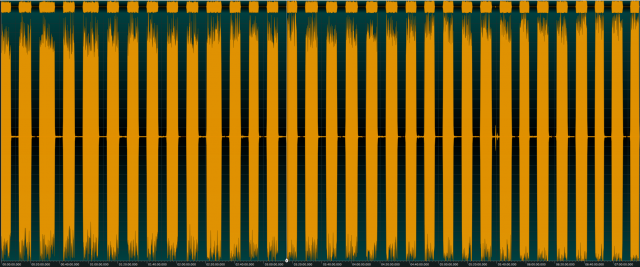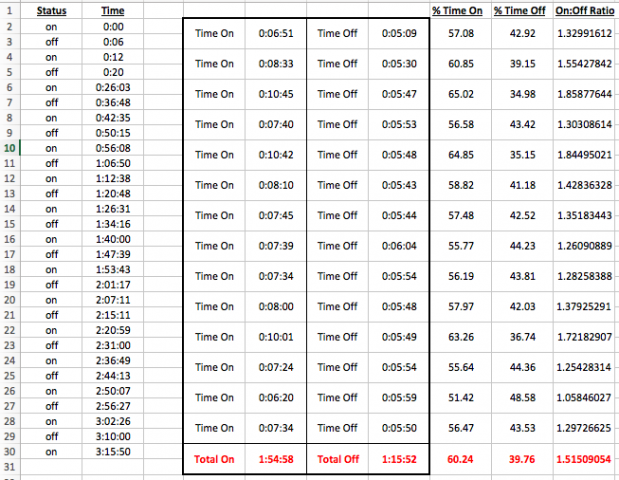Thanks again for all of the responses and insights. Here are some updates:
• The mass consensus is that my problem is likely related to poor insulation, and I think that this is highly probable. I was not present for much of the construction, as I sometimes travel for work. So, I do not know what material was used for insulation because I was not around for this part of the construction, but I am fairly certain that he used fiberglass batts. That appears to be used in one of the pictures (below) showing the back of the chiller, and I can see it poking out of the ceiling from the room adjacent the cellar (again, see pics below).
• I am reaching out to the contractor with a long and detailed list of questions and thoughts. I will bring any interesting responses to this forum. But, in the interest of others benefiting from my problem, here are the pertinent points/questions I am raising:
Possible Problem #1 - The chiller is not functioning properly
- This does not seem to be the case, but I suppose it is possible
- Is this chiller designed to drop a temperature down to any of it’s possible set temps despite the immediate surrounding ambient temp (even if only briefly)? It seems like it should be. If so, is the fact that it cannot a sign of a chiller or insulation problem?
- How would we even determine whether the chiller is functioning properly?
- Can Wine Guardian directly look at the set up? Do they have service reps in the area?
Possible Problem #2 - The chiller is not sufficient for the space
- Also unlikely, the space is about 500 cubic feet and the chiller is rated to 1500 cubic feet
- Did we make a mistake with a TTW unit? What would be involved (time, expense, etc) for a split system? Is this even a reasonable idea?
Possible Problem #3 - There is an insulation problem
- This is starting to seem more probable, and anyone I speak to who has a cellar asks about this
- Is the fact that it cycles on/off pretty fast in the winter at 57° – and blows continuously in the summer even at 61° – a sign that this is the problem?
- I would expect a properly insulated room to lose heat much more slowly than this room does
- It seems like the chiller is trying to compete against a constant inflow of ambient air, and this may be why it cannot drop below certain set temperatures
- What kind of insulation did Mike use in the walls and ceiling? What was the R value of this insulation?
- How would we determine an insulation problem?
- How would we fix an insulation problem now that the cellar is fully built?
Possible Problem #4 - Everything was built fine and is functioning fine
- This would imply that there is some other problem that we just might never identify
- I’ve spoken with several people in Chicago with basement cellars. Some admit that their chiller runs longer in the summer, but none have the problems that I am having with achieving set temp or constant blowing of the chiller.
- This leads me to believe that though it is challenging to achieve temperature equilibrium, it is certainly not impossible and that my issues are not typical.
- If we leave the cellar as is, the wine will certainly be fine, but
- The life of the chiller will decrease, and we may find ourselves going through several of them in our lifetime
- Our electricity bills will certainly suffer
- Do we just accept that the cellar will not function as I had expected and move on?
Some additional random questions about the chiller, for my understanding
- Is the chiller designed to blow colder air when you decrease the set point, or just blow longer at the same output temperature?
- Does the chiller always blow air of the same temperature? Does the output temperature ever vary?
- What is the expected lifespan of the chiller?
- What is the ideal cycling on time and off time in order to achieve that lifespan?
- What are the triggers for the chiller to turn off and on?
• I am attaching some of my measurements from late November 2015 in Chicago, note that the series of 3 measurements at each location correspond with chiller set points of 57, 55, 52:
https://drive.google.com/open?id=0B3jpFSYFftuXc1ZlWl9LMFZiYlk
https://drive.google.com/open?id=0B3jpFSYFftuXT0pnWUJLbnpWZDg
https://drive.google.com/open?id=0B3jpFSYFftuXcnBnR0hjMURfZHM
https://drive.google.com/open?id=0B3jpFSYFftuXTDg4a3hkR09JSDQ
https://drive.google.com/open?id=0B3jpFSYFftuXWXNaTEV4Z0VGV3c
https://drive.google.com/open?id=0B3jpFSYFftuXczg2Z0h1WFpWcVk
https://drive.google.com/open?id=0B3jpFSYFftuXQVVjV1JaZUxnc1U
• Here are some photos of the cellar:
Exterior
https://drive.google.com/open?id=0B3jpFSYFftuXdS1yeUpJbVhKMWc
https://drive.google.com/open?id=0B3jpFSYFftuXbWVrUWkzeUlxb3M
Facing the back of the cellar
https://drive.google.com/open?id=0B3jpFSYFftuXTEtSNWJPRk14Xzg
Facing the front (left) from the back
https://drive.google.com/open?id=0B3jpFSYFftuXY0JKblZwNUMwSHM
Facing the front (right) from the back
https://drive.google.com/open?id=0B3jpFSYFftuXbUFPYlRsYWg5YzQ
The left door houses the back end of the chiller and the ducting
https://drive.google.com/open?id=0B3jpFSYFftuXeDZGcm54Q3NZeVE
Detailed back end view of the chiller/duct
https://drive.google.com/open?id=0B3jpFSYFftuXamNTWmFfUGdKakk
The duct continues across the room and to the bottom…
https://drive.google.com/open?id=0B3jpFSYFftuXeUtJeW5qaWVyVTg
…where it vents into the hallway
https://drive.google.com/open?id=0B3jpFSYFftuXQ0pjYjRIekxSTkk
• I have noticed some very unusual and concerning trends that bring me right back to my problems this past winter, when the chiller could not get the room down to 55. First, I decided to raise the set point from 57 to 60 (since it was not getting below 60 in the first place). The chiller shut off, and I checked several hours later. It blows continuously and displays 60. I set it to 61, and the same thing happened. It shut off, and then 30 minutes later it is blowing and displaying 61. Three hours later, it is still blowing and displaying 61. I raised the set point to 62. Same thing. It shuts off for a bit, then starts blowing, and blows continuously while displaying 62. So even though it demonstrates an ability to get down to a certain temperature, it seems to have great difficulty chilling below the set temperature.
• Second, I played around with my IR thermometer a bit more. I know that someone told me to ditch it, but I’m just looking for correlations and leads to act on. My liquid bottle thermometer was reading 60.1, and the IR thermometer showed 60.6. Good enough. So what I have found is that my floor is warmer than my ceiling. Now, I should preface this by saying that we know that we have floor heating in the basement. However, the contractor told us that we do not have it under the cellar. We did not build the home, we bought it a couple of years ago, and there is no floor heating depicted anywhere on the blueprints (but we definitely have it), so we went with his assessment. The location of the cellar was not originally a “useable” part of the basement, it was essentially a dungeon-like storage area that was no finished at all. The original flooring where the cellar now sits was poured concrete, and so all together it seemed logical to us that this would be a very unusual location to need floor heating. We believed his assessment, and until today I really had no reason to second guess it. Anyhow, I have discovered that the floor is currently measuring anywhere from 70-73 degrees with my IR thermometer. This is while the chiller shows 62, the walls show anywhere from 60 to 65, and the ceiling shows anywhere from 62-65. Sure enough, the bottles closest to the floor are measuring 64-65, and those that are in line but close to the ceiling measuring 60-62. Strange.
• So I asked my wife about the floor heating and whether it was on or off. She was advised by our HVAC people to start it up mid summer, as it is very slow to build (and also to recede) and takes weeks to months to get to full effect when turned on or off. Sure enough, she turned it on a couple of weeks ago. We turned it off to see what happens.
• Even stranger is that there appear to be pockets in the cellar where the floor is warm in a single 1x1 foot area. Like, I can feel it with my bare feet. In fact, this is what first made me check these floor temps today. It feels like a warm spot in the floor, and I can move my IR thermometer across the floor and predict exactly where it starts and stops. Is this a curiosity of the ground under my home? Is this evidence of floor heating, which I was assured was NOT present where the cellar was being built? Who knows.
• What is even stranger yet is that during the winter, when the floor heating was cranked to full effect, there did not appear to be any floor/ceiling disparity like there is now. See my measurements taken in late November above for details. So why is this popping up in the summer? You would think that in the winter the problem would be even more obvious, but the floor and ceiling were actually pretty close in temperature back then.
So I have no idea where to go from here. I’m obviously not going to tear down the cellar to take corrective measures that might or might not work. I just have no idea what to do with the chiller. And now that I have these weird pockets of warmth on the floor, I need to figure out if I should place my long term storage bottles in areas that are demonstrably cooler, and my short term storage bottles in the slightly warmer areas?
Anyhow, thanks again for everyone’s insight. Sorry if this was a massive information dump. It’s how I roll.


